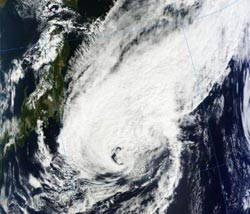NASA sees extra-large, now extra-tropical storm Prapiroon fading

The MODIS instrument aboard NASA's Terra satellite captured this visible image of Extra-tropical Storm Prapiroon on Oct. 19 at 01:15 UTC (Oct. 18, 9:15 p.m. EDT), about 270 nautical miles southeast of Tokyo, Japan and moving away.<br><br>Credit: NASA Goddard MODIS Rapid Response<br>
The Moderate Resolution Imaging Spectroradiometer (MODIS) instrument aboard NASA's Terra satellite captured a visible image of Extra-tropical Storm Prapiroon on Oct. 19 at 01:15 UTC (Oct. 18, 9:15 p.m. EDT).
The storm appeared on the MODIS image to be as large as the main island of Japan and the strongest thunderstorms and heaviest rainfall appeared north of the center of circulation over the open waters of the western North Pacific Ocean.
At 0300 UTC on Oct. 19 (11 p.m. EDT on Oct. 18), Prapiroon's maximum sustained winds were near 45 knots (51.7 mph/81.3 kph). It was centered about 270 nautical miles (310.7 miles/500 km) southeast of Tokyo, Japan, near 31.9 North latitude and 142.6 East longitude. It was moving away from Japan and headed east-northeast at 27 knots (31 mph/50 kph).
On Oct. 19, Prapiroon marked its twelfth day of life. It was born as Tropical Depression 22W on Oct. 7. On Monday, Oct. 8, the twenty-second tropical cyclone had organized and strengthened into Tropical storm Prapiroon and later became a typhoon. Now, as an extra-tropical cyclone, Prapiroon is expected to fade over the next couple of days over open waters.
Media Contact
More Information:
http://www.nasa.govAll latest news from the category: Earth Sciences
Earth Sciences (also referred to as Geosciences), which deals with basic issues surrounding our planet, plays a vital role in the area of energy and raw materials supply.
Earth Sciences comprises subjects such as geology, geography, geological informatics, paleontology, mineralogy, petrography, crystallography, geophysics, geodesy, glaciology, cartography, photogrammetry, meteorology and seismology, early-warning systems, earthquake research and polar research.
Newest articles

A new look at the consequences of light pollution
GAME 2024 begins its experiments in eight countries. Can artificial light at night harm marine algae and impair their important functions for coastal ecosystems? This year’s project of the training…

Silicon Carbide Innovation Alliance to drive industrial-scale semiconductor work
Known for its ability to withstand extreme environments and high voltages, silicon carbide (SiC) is a semiconducting material made up of silicon and carbon atoms arranged into crystals that is…

New SPECT/CT technique shows impressive biomarker identification
…offers increased access for prostate cancer patients. A novel SPECT/CT acquisition method can accurately detect radiopharmaceutical biodistribution in a convenient manner for prostate cancer patients, opening the door for more…




















